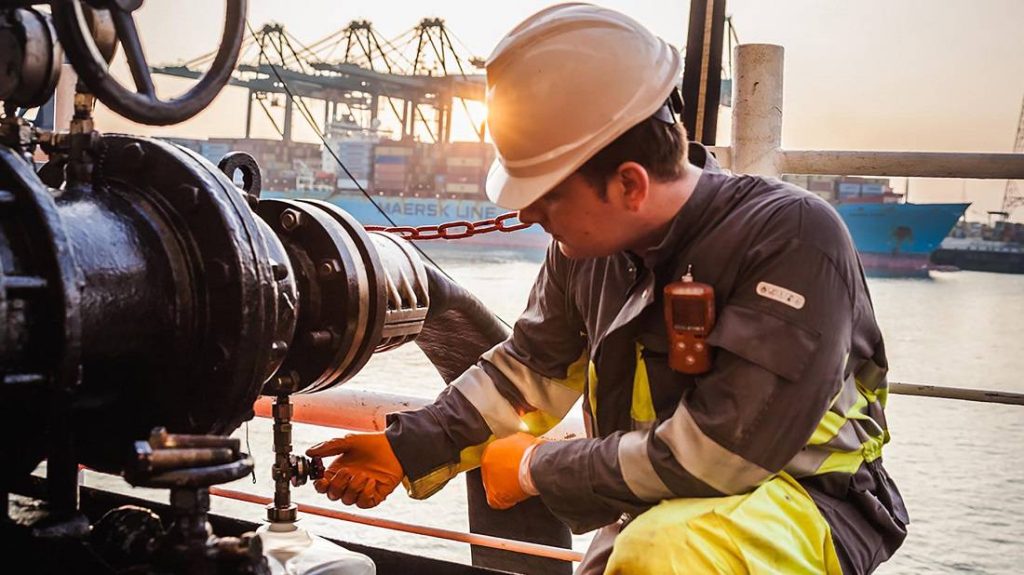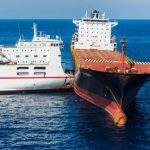This cargo sampling instruction describes the guidance for the Master and his crew in ensuring that appropriate samples of the cargo to be loaded or discharged are being taken as evidence to be used in connection with presented claims for contaminated cargo and for the purpose of protecting the vessel and the Company’s interests.
Procedure
· Cargo sampling should be done in closed condition. (Note: most vessels are screened / accepted by oil majors based on closed sampling requirements.)
· Should this not be possible, Owner/Operator must be advised.
· If the cargo product has been loaded and no samples have been drawn from the manifold at commencement of loading, the vessel can very easily be claimed for any contamination of the cargo and which contamination in fact may have been caused by polluted lines or hoses at the shore installation. Samples taken from Manifold and cargo tanks are the only proof that Owners have against possible cargo claims.
Cargo Sampling of Products to be Loaded / Discharged:
Sampling of each cargo product to be loaded or discharged shall be carried out as described in OCIMF’s “International Safety Guide for Oil Tankers & Terminals” (ISGOTT) and always in compliance with the Owner’s procedures.
Vessel shall always ensure following samples are drawn and ensure same is witnessed by surveyor;
Cargo Sampling at Load port
· Upon commencement of loading (manifold samples, first cargo passing each manifold)
· Just before 1st foot sample is loaded (cargo tank samples)
· When about 50% of cargo has been loaded (manifold samples)
· Upon completion of loading (cargo tank composite samples)
Additional manifold samples shall always be drawn upon;
· Re-start of cargo operations when there is a stop during the loading operation
· Change of shore tank(s) during loading
· Terminal is stripping/debottoming tanks into vessel’s cargo tanks during loading
If there exists doubt onboard as to when further samples to be drawn, then decision shall always be to draw the additional samples.
During pre-loading meeting the vessel shall check with Loading Master if the terminal has any plans of stripping, debottoming or change of shore tanks.
A visual check of cargo samples, to determine any suspected contamination, must always be carried out by an experienced officer.
If any suspected contamination found in the samples then below steps to be undertaken;
Vessel must immediately stop loading and immediately contact the Owner/Operator and await their further orders. The Master is to send pictures of cargo manifold and ship tank sample(s) – Such pictures to be taken with white background. Master also to advise at what time intervals such samples were taken as well as how much cargo has been loaded and into which tanks. Master also to advise the surveyor’s and terminal’s reasons for the apparent contamination.
In any case, pictures of the manifold and a representative composite tank sample, against a white background, shall always be emailed to the Owner/Operator after loading, in order to evaluate if cleaning is needed for subsequent voyages.
Cargo Sampling at Discharge port
· Prior commencement of discharging (cargo tank composite samples)
· On arrival at the discharge port, and immediately after tank ullages and temperatures have been carefully checked, samples should be taken of all cargo onboard. This sampling is usually carried out by the consignee’s surveyor and the procedure should be attended by vessel’s officers. It is usual to take top, middle, lower and bottom samples, though depending on the cargo. In the event of cargo that remains homogeneous during the voyage, such samples may be mixed into a composite sample with the largest proportion coming from the middle depth of the tank. It is also desirable to use a water finding instrument to establish if water is present.
· Manifold samples taken at the vessel’s manifold at the start of discharge
If there exists doubt onboard as to when further samples to be drawn, then decision shall always be to draw the additional samples.
A visual check of cargo samples, to determine any suspected contamination, must always be carried out by an experienced officer.
It is recognized that drawing of samples at the manifold during the initial loading operation may be difficult due to vacuum in the lines. If this is not possible and not in compliance with the Owner’s procedures samples should be drawn from the tank(s) in which the loading has been initiated (First foot sample)
If the terminal, for any reason, prevents the ship to carry out quality control sampling as required the same should be stated in the ship’s cargo operations log book and Owner/Operator should be contacted immediately and notified about same.
Manifold sample should normally be taken against closed valve (sample before product entering the ship’s line). This can only be done if the terminal can gravitate or pump at a very slow rate.
If, however the terminal has a restriction on this practice and the ship is unable to take a manifold sample, a running sample should be taken as close as possible to the shore line connection.
A comment detailing the position of the sample taking should be included in the ship’s cargo operations log.
An accurate record of the manifold rigging, the loading times for each tank (start/stop) and any foot sampling sequence must also be maintained in order to identify the source of any contaminant should there be a failure of a sample by any test.
Samples shall only be drawn from each individual cargo tank if this is being requested by the Shipper or Charterers.
Cargo Sampling by Surveyors/Shippers:
All “first-foot” samples drawn during loading must be witnessed by a responsible officer of the vessel, divided and the vessel is to retain one sealed sample on board of this or these samples.
Upon completion of loading, the drawing of samples from the vessel’s cargo tanks or the vessel’s composite sampling must be witnessed by a responsible officer of the vessel. Samples from Cargo tanks must be taken at 3 levels, bottom, middle and top in order to represent all cargo inside tank. If Surveyor/shippers refuse to do same, then master to issue LOP (Letter of Protest) and notify Owner/Operator immediately. The vessel must retain one full sealed set in addition to those samples being delivered by the shore installation for carriage by the vessel and being handed over by the Master to the receivers at the discharge port.
· Ensure a clean, dry and new sampling bottle is used each time for sampling and the sampling outlet always flushed before drawing a sample.
· The closed sampling device should be thoroughly cleaned, dried and any traces of previous cargo completely removed. If several cargoes loaded at the same time, then sampler to be cleaned in between each grade.
· A sample should be drawn immediately at the manifold on commencement of loading of every grade to ensure the correct product is being received.
· If in doubt STOP LOADING and re-confirm with terminal / surveyor.
· When loading certain sensitive cargoes, the Cargo Surveyor, on behalf of the Suppliers, may take running foot-samples from the ship’s receiving tanks for basic visual analysis. Vessel should retain on set of such samples.
· On completion of sampling the surveyor will place on board sample drawn from the ships and shore tanks for cargo receivers. The vessel shall retain at least one set. When samples are landed ashore, the master shall ensure that a sample land receipt to be obtained. On every occasion whenever surveyor takes sample from the ship tanks, vessel shall ensure to keep one set of such samples onboard.
· When the shore is using a line displacement method for loading, i.e. when multi-grades are being loaded by the same lines and on completion of one grade the same is displaced by the second grade; samples should also be drawn at the manifold on completion of every grade.
· At the discharge port, the Cargo Surveyors on behalf of the receivers normally draw samples, from each tank for analysis. After clearance is received from ashore, discharge is commenced, and samples should then be taken at the manifold at commencement of every grade.
· If the surveyor / terminal representative refuses to seal any samples, endeavour to get the surveyor’s / terminal representative’s signature on a letter acknowledging that the said line and foot samples were taken in his presence. In absence of above, the Chief Officer must ensure that he himself seals and labels the samples. He should also make a note on the letter that the samples were taken in the Surveyors presence, but he refused to seal them / sign the letter.
· In all cases where the Surveyor wishes or is instructed to draw only a single sample just for the shore reference, he should be persuaded to draw an additional one for the vessel’s retention as well.
· All shore tank / line samples being delivered to the vessel shall be accepted for delivery only and a remark entered on the cargo sampling receipt stating that “Vessel’s Staff did / did not attend the Sampling Procedure” (delete as applicable).
Marking and Storage of Samples:
Marking and storage of samples shall comply with the Owner/Operator’s instructions.
In case Owner/Operator do not have procedures/instructions for marking samples, the below information shall be used as minimum:
· Vessels name
· Port / Terminal
· Date / Time of Sampling
· Seal number
· Cargo Name and Grade
· Destination and Shipper
· Manifold No. and/or Cargo Tank No.
· Sample type (top, middle, bottom, running, composite)
· Name/Rank of Person responsible for drawing sample
All Cargo samples should be retained on board for at least 12 months and all Manifold samples should be retained onboard for 3 months.
Disposal of all samples should be done in compliance with MARPOL regulations.



Comments are closed